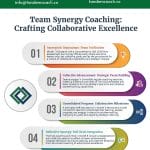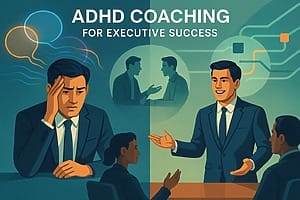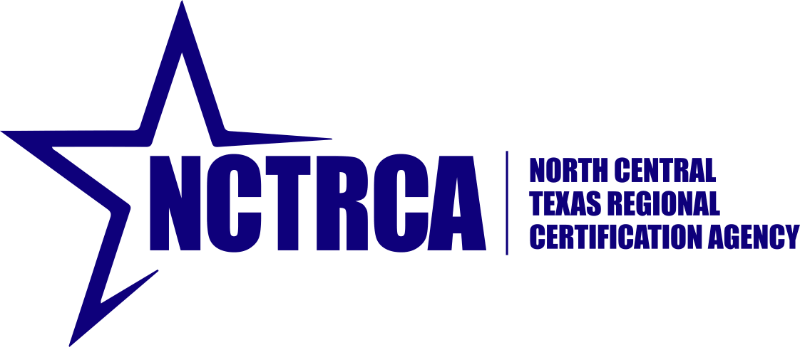TL;DR: Your environment isn’t neutral – it either supports or sabotages your ADHD executive brain. By intentionally designing physical spaces, digital systems, and administrative structures that work with your sensory needs and executive function patterns, you can transform your workplace from a daily battle into a launching pad for exceptional performance.
“I feel like I’m drowning in my own office,” Patricia said during our virtual coaching session. She was calling from her car in the parking garage – the only place she could think clearly anymore. As a Chief Marketing Officer of a major retail brand, she had what most would consider an enviable corner office with floor-to-ceiling windows and an open-door policy that kept her connected to her team.
“Everything seems to happen at once,” she sighed. “The windows face a busy street – constant movement catches my eye. My desk faces the door, so every person walking by breaks my concentration. The overhead fluorescents give me headaches. And don’t get me started on the notifications – between Slack, email, and calendar reminders, I feel like I’m being pecked to death by digital chickens.”
“What would it be like if your environment worked with your brain instead of against it?”
Patricia was quiet for a moment. “I honestly can’t imagine it. I’ve always just assumed this was the price of leadership – that I needed to tough it out.”
That conversation launched a complete environmental overhaul that transformed not just Patricia’s workspace, but her entire approach to executive performance. Within three months, she’d gone from feeling overwhelmed and scattered to leading with clarity and focus. The difference? She stopped trying to overcome her environment through willpower and started designing it to support her ADHD brain’s unique needs.
The Hidden Environmental Tax on ADHD Executive Performance
In my coaching practice, I’ve noticed that ADHD executives often don’t realize how much energy they’re spending just managing their environment. You might be brilliant at strategy, exceptional at innovation, and gifted at leadership – but if you’re using 40% of your cognitive resources just filtering out distractions, you’re operating with one hand tied behind your back.
Research on ADHD and workplace environment shows that environmental factors can significantly impact productivity and performance for neurodivergent individuals. Yet most executive spaces are designed for neurotypical brains – assuming that everyone can filter out background noise, ignore visual distractions, and manage multiple digital inputs simultaneously.
What if we flipped the script? What if instead of expecting ADHD executives to adapt to hostile environments, we designed environments that amplify their strengths?
Understanding Your Sensory Profile
Before you can optimize your environment, you need to understand your unique sensory needs. Through working with hundreds of ADHD executives, I’ve found that sensory profiles vary dramatically, even among people with the same diagnosis.
“I need background noise to focus,” Marcus, a CFO, told me. “Complete silence makes my brain create its own distractions.”
Meanwhile, Sarah, also a CFO at a different company, said, “Any unexpected sound can derail my entire thought process. I need absolute quiet to do deep work.”
Both are successful ADHD executives. Both have completely different sensory needs. Understanding your individual profile is the foundation of effective environmental design.
Consider these sensory dimensions:
Auditory Processing: Do you need silence, white noise, or specific types of sound to focus? How do sudden noises affect you?
Visual Sensitivity: Are you distracted by movement, affected by lighting types, or sensitive to visual clutter?
Tactile Preferences: Do certain textures help you focus? Do you need to fidget? How does temperature affect your concentration?
Olfactory Awareness: Are you sensitive to scents? Do certain smells enhance or hinder your focus?
Proprioceptive Needs: Do you need to move to think? Does sitting still help or hinder your processing?
Creating Your Physical Sanctuary
Research indicates that workspace design significantly impacts neurodivergent employee performance. Here’s how to create an executive environment that supports rather than sabotages your success:
Strategic Workspace Positioning
Where you position yourself in your office matters more than you might think. Patricia’s breakthrough came when she simply turned her desk 90 degrees so her back was to the window and she faced a calming wall instead of the door.
“That one change gave me back two hours of productive time per day,” she reflected. “I wasn’t constantly being pulled by visual distractions.”
Consider your optimal positioning:
- Back to windows to minimize movement distractions
- Facing away from high-traffic areas
- Creating visual barriers without feeling closed in
- Ensuring easy access to everything you need without excessive movement
Lighting That Works With Your Brain
Studies show that neurodivergent individuals often have heightened sensitivity to lighting. Yet most offices still use harsh fluorescent lighting that can trigger headaches, eye strain, and concentration difficulties.
James, a technology executive, discovered that switching to adjustable LED panels with warm tones transformed his ability to focus. “I didn’t realize how much energy I was spending just tolerating the lighting until I changed it,” he said.
Lighting strategies that work:
- Multiple light sources for flexibility
- Bias lighting behind monitors to reduce eye strain
- Natural light filtered through adjustable blinds
- Task lighting for detailed work
- Avoiding overhead fluorescents when possible
Sound Management Strategies
For many ADHD executives, sound is the make-or-break environmental factor. The challenge is that your sound needs might vary throughout the day or depending on the task.
Creating acoustic zones in your office allows flexibility:
Focus Zone: Where deep work happens, optimized for your preferred sound environment Communication Zone: Where calls and meetings occur, with different acoustic properties Transition Zone: A buffer space between your office and the outside world
“I installed a white noise machine near my door,” shared Rebecca, a pharmaceutical executive. “It creates a sound barrier that signals to my brain that I’m in focus mode, while also masking unpredictable outside noises.”
Managing Visual Distractions
Your ADHD brain is constantly scanning for novelty and potential threats – an evolutionary advantage that becomes a liability in visually chaotic environments. Creating visual calm doesn’t mean sterile minimalism; it means intentional design.
Visual strategies that support focus:
- Using solid colors rather than patterns
- Organizing items in closed storage to reduce visual noise
- Creating one focal point that’s calming or inspiring
- Positioning monitors to minimize glare and peripheral distractions
- Using plants strategically to create visual barriers and add biophilic benefits
Digital Environment Optimization
Your digital environment is just as important as your physical space – and often more challenging to manage. ADHD executives typically juggle multiple platforms, endless notifications, and information overload that would challenge any brain.
Notification Sovereignty
“I realized I was letting everyone else control my attention through notifications,” said Michael, a marketing executive. “Every ping was someone else deciding what I should focus on.”
Taking control of your digital environment starts with radical notification management:
- Turn off all non-essential notifications
- Use focus modes that limit interruptions
- Schedule specific times for communication checks
- Create different notification profiles for different work modes
Technology tools designed for ADHD can help, but only if they’re configured to support rather than distract.
Information Architecture That Makes Sense
How you organize digital information can either support or sabotage your executive function. Traditional folder hierarchies often don’t work well for ADHD brains that think in associations rather than categories.
“I switched to a tag-based system,” explained Jennifer, a CEO. “Now I can find things based on how my brain actually remembers them – by project, person, or context – rather than trying to remember which folder I put something in.”
Digital organization strategies:
- Visual filing systems with colors and icons
- Search-based retrieval rather than navigation
- Consistent naming conventions that your brain understands
- Regular digital decluttering sessions
- Templates for recurring tasks to reduce decision fatigue
Screen Setup for ADHD Success
Your monitor configuration can significantly impact your ability to focus and process information. Many ADHD executives benefit from multiple screens – but only if they’re set up strategically.
“I use three monitors,” David, a finance executive, explained. “Left is for reference materials, center for active work, right for communication. Each has a specific purpose, which helps my brain compartmentalize.”
Administrative Support Systems
Perhaps the most underutilized environmental support for ADHD executives is human support – specifically, administrative professionals who understand how to work with neurodivergent leaders.
Partnering with Administrative Professionals
The key to effective administrative support isn’t finding someone to do things for you – it’s finding someone who understands how to create systems that work with your brain.
“My executive assistant is my external executive function,” laughed Patricia. “She doesn’t judge when I have seventeen half-finished projects. Instead, she helps me create systems to track them all and gently nudges me toward completion.”
Effective administrative partnership involves:
- Clear communication about your ADHD-related needs
- Collaborative system design rather than imposed structure
- Regular check-ins to refine approaches
- Respect for both your strengths and challenges
Creating Communication Protocols
One of the biggest challenges for ADHD executives is managing the constant flow of communication. Administrative support can help create buffers and filters that protect your focus while ensuring nothing critical falls through the cracks.
Rachel’s assistant developed what they call the “Traffic Light System”:
- Red: Urgent items requiring immediate attention
- Yellow: Important but not urgent, addressed during scheduled check-ins
- Green: FYI items reviewed during weekly planning
“This system means I’m not constantly context-switching,” Rachel explained. “I can trust that real emergencies will reach me while everything else waits for the appropriate time.”
Calendar Architecture for ADHD Brains
Traditional calendar management often doesn’t account for ADHD needs like transition time, energy management, and variety requirements. Effective administrative support includes designing calendar structures that work with your patterns.
“My assistant builds in buffer time between meetings,” shared Robert, a hospital administrator. “She knows I need 15 minutes to transition mentally, capture notes, and prepare for what’s next. She also varies meeting types throughout the day to match my energy patterns.”
Calendar strategies that work:
- Color coding by energy requirement, not just topic
- Building in transition and processing time
- Protecting hyperfocus blocks
- Varying meeting types and formats
- Including movement and restoration breaks
Environmental Audit Checklist
Use this comprehensive tool to assess and optimize your executive environment:
Physical Space Audit
Lighting:
- Can you adjust brightness levels?
- Do you have alternatives to overhead fluorescents?
- Is natural light filtered appropriately?
- Do you have task lighting options?
Sound:
- Can you control ambient noise levels?
- Do you have sound masking options?
- Are there unexpected noise sources to address?
- Can you create different acoustic zones?
Visual:
- Is your sightline free from distracting movement?
- Have you minimized visual clutter?
- Are colors and patterns supportive rather than distracting?
- Do you have a calming focal point?
Comfort:
- Can you adjust temperature easily?
- Do you have movement options (standing desk, balance board)?
- Are tactile elements (chair, desk surface) comfortable?
- Is air quality good?
Digital Environment Audit
Notifications:
- Have you eliminated non-essential alerts?
- Do you control when you receive communications?
- Are visual notifications minimized?
- Can you easily enter focus mode?
Organization:
- Does your filing system match your thinking patterns?
- Can you quickly find what you need?
- Are templates reducing repetitive decisions?
- Is digital clutter regularly managed?
Tools:
- Are your apps and platforms ADHD-friendly?
- Do you have appropriate backup systems?
- Are passwords and access streamlined?
- Do tools integrate well together?
Administrative Support Audit
Communication:
- Are protocols clear and consistent?
- Does support staff understand your ADHD needs?
- Is there appropriate filtering of information?
- Are check-in schedules optimized?
Systems:
- Do organizational systems work with your brain?
- Is there flexibility to adjust approaches?
- Are visual and reminder systems in place?
- Is progress tracking ADHD-friendly?
Calendar:
- Does scheduling account for energy patterns?
- Are transitions and buffers built in?
- Is variety incorporated appropriately?
- Are focus blocks protected?
Advanced Environmental Strategies
As you become more sophisticated in environmental design, you can implement advanced strategies that further optimize your executive performance:
Biophilic Integration
Research shows that nature connection significantly impacts wellbeing and performance. For ADHD executives, biophilic design elements can provide both calming and stimulating effects.
“I turned one wall into a living plant wall,” shared Lisa, a healthcare executive. “It gives my eyes something organic to rest on, improves air quality, and somehow helps my brain feel less confined by the office walls.”
Sensory Rotation Strategies
Your sensory needs aren’t static – they change based on stress levels, sleep quality, hormones, and dozens of other factors. Creating an environment that can adapt to these changes is crucial.
“I have what I call ‘sensory settings’ for my office,” explained Thomas, a legal executive. “High-stimulation days get dim lights and white noise. Low-energy days get bright lights and upbeat music. I’ve learned to read my needs and adjust accordingly.”
Environmental Anchoring
Using environmental cues to trigger specific mental states can help ADHD executives transition more effectively between different types of work.
“I have different spaces within my office for different activities,” Maria shared. “The reading chair is only for strategic thinking. The standing desk is for calls. My main desk is for focused work. My brain has learned these associations, which helps me shift gears more easily.”
Common Environmental Pitfalls to Avoid
As you optimize your environment, watch out for these common mistakes:
Over-Optimization Paralysis
Sometimes ADHD executives become so focused on creating the perfect environment that they never actually work in it. Remember: good enough today beats perfect tomorrow.
Ignoring Energy Costs
Every environmental adaptation requires energy to implement and maintain. Make sure the benefit outweighs the cost of constant adjustment.
Comparison Trap
Your optimal environment might look nothing like another successful executive’s space. Trust your own sensory needs rather than copying what works for others.
Static Thinking
Your environmental needs will evolve. What works during a calm period might not work during crisis. Build in flexibility from the start.
The Ripple Effect of Environmental Optimization
When Patricia finally optimized her environment, the effects went far beyond her personal productivity. “My team noticed I was more present, less reactive, and generally happier,” she reflected. “They started asking what had changed, which opened up conversations about neurodiversity and environmental needs.”
Creating an ADHD-friendly executive environment often has ripple effects:
- Teams become more aware of diverse needs
- Organizations start considering neurodiversity in design
- Other executives feel permission to advocate for their needs
- Company culture shifts toward greater inclusivity
Your Environmental Revolution
What would be possible if your environment actually supported your ADHD brain? If every element of your physical space, digital systems, and administrative support was designed to amplify your strengths rather than drain your energy?
The executives I’ve coached who’ve embraced environmental design report profound changes: increased productivity, reduced stress, better decision-making, and perhaps most importantly, the energy to be fully present for both work and life.
“I used to come home exhausted every day, with nothing left for my family,” Patricia told me recently. “Now I have energy for evening activities, weekend projects, and actually enjoying my success. All because I stopped fighting my environment and started designing it.”
Your environment is either working for you or against you – there’s no neutral. The question isn’t whether you can afford to optimize your environment; it’s whether you can afford not to.
Start with one change this week. Maybe it’s turning your desk. Maybe it’s adjusting your lighting. Maybe it’s having an honest conversation with your administrative support about what you really need. Notice the impact. Build from there.
Your ADHD brain deserves an environment that honors its unique wiring. When you create that environment, you don’t just improve your performance – you model what inclusive leadership looks like and pave the way for others to thrive.
What environmental change will you make today? What support will you ask for? What would be possible if you stopped tolerating environmental friction and started designing for environmental flow?
Frequently Asked Questions
What are the most important environmental modifications for ADHD executives?
The most critical modifications vary by individual, but consistently important areas include lighting control, sound management, and visual distraction reduction. Start with adjustable lighting to eliminate harsh fluorescents, add sound control through white noise or acoustic treatments, and minimize visual clutter through strategic positioning and storage. Beyond these basics, focus on creating flexibility – environments that can adapt to your changing needs throughout the day. Many executives find that investing in a high-quality chair and desk setup pays dividends, as physical comfort directly impacts cognitive function. Remember: the best modifications are the ones that address your specific sensory triggers and support needs.
How do I work with administrative staff who don't understand ADHD needs?
Start with education, not demands. Share specific examples of how ADHD impacts your work style, focusing on practical implications rather than medical details. For instance: “I process information better with visual summaries” is more helpful than “I have executive function challenges.” Create clear, written protocols together that outline communication preferences, scheduling needs, and organizational systems. Be patient – it may take time for support staff to understand that your needs aren’t preferences but necessities. Consider sharing resources about supporting neurodivergent executives, and always acknowledge when they get it right. Most importantly, frame it as a partnership where you’re both working toward the same goal: your optimal performance.
What's the ideal balance between minimalism and having necessary items accessible?
The key is “intentional accessibility” rather than pure minimalism. ADHD brains often work on “out of sight, out of mind” principles, so hiding everything can be counterproductive. Instead, create zones: keep current project materials visible but organized, store reference materials in labeled, clear containers, and remove anything unrelated to present work. Use the “arm’s reach” rule – frequently used items should be easily accessible without breaking focus. Visual cues like color coding can help you quickly locate what you need without creating clutter. Remember: the goal isn’t an Instagram-worthy office but a functional space that supports your brain’s processing style.
How can I create an ADHD-friendly environment in a traditional corporate setting?
Work within constraints by focusing on what you can control. Even in open offices, you can create micro-environments using portable solutions: noise-canceling headphones, desk screens for visual barriers, and personal lighting. Request accommodations through appropriate channels – many modifications fall under reasonable accommodations. Frame requests in terms of productivity and performance rather than disability. Build alliances with facilities and IT teams who can help implement solutions. Consider booking different spaces for different work types – quiet rooms for deep work, collaborative spaces for meetings. Most importantly, be a pioneer: your advocacy for ADHD-friendly environments paves the way for others and contributes to a more inclusive workplace culture.
Ready to transform your executive environment from an obstacle course into a launching pad? You don’t have to continue fighting against your surroundings to succeed. I’m here to help you design comprehensive environmental and administrative supports that work with your ADHD brain, not against it.
Schedule your free consultation with Tandem Coaching Partners to begin creating an executive environment that amplifies your strengths and supports your success.



Boost Your Leadership Team Success!
Take your leadership team to the next level and achieve great results with our executive coaching.
Learn how our coaching and ASPIRE method can change things for you—get a free brochure to begin your journey.
About the Author
Cherie Silas, MCC
She has over 20 years of experience as a corporate leader and uses that background to partner with business executives and their leadership teams to identify and solve their most challenging people, process, and business problems in measurable ways.



![Why is Leadership Development Important? [Quick Answer]](https://cdn.tandemcoach.co/wp-content/uploads/2024/08/TC-215.jpg)











